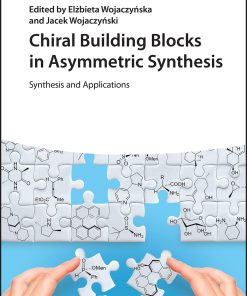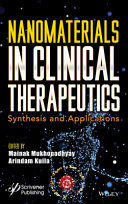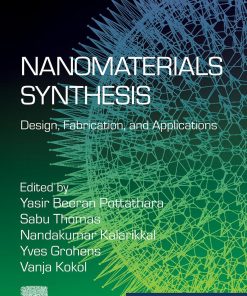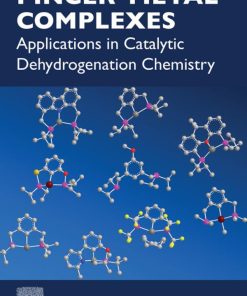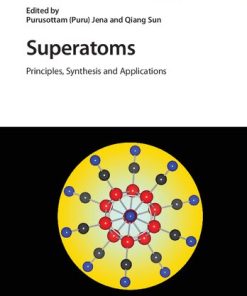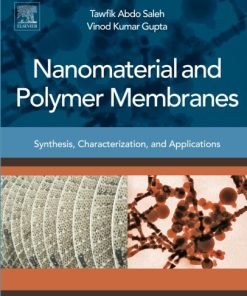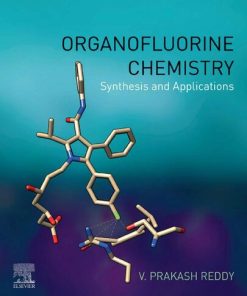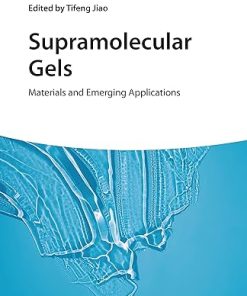(Ebook PDF) Supramolecular Coordination Complexes Design Synthesis and Applications 1st Edition by Sankarasekaran Shanmugaraju 0323907059 9780323907057 full chapters
$50.00 Original price was: $50.00.$25.00Current price is: $25.00.
Supramolecular Coordination Complexes: Design, Synthesis, and Applications 1st Edition by Sankarasekaran Shanmugaraju – Ebook PDF Instant Download/DeliveryISBN: 0323907059, 9780323907057
Full download Supramolecular Coordination Complexes: Design, Synthesis, and Applications 1st Edition after payment
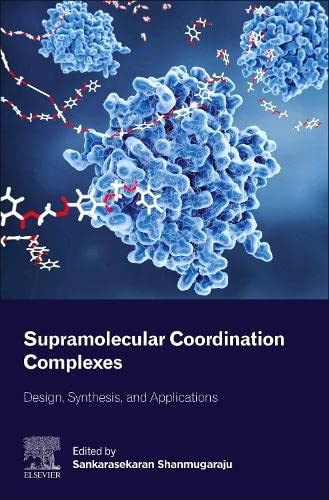
Product details:
ISBN-10 : 0323907059
ISBN-13 : 9780323907057
Author: Sankarasekaran Shanmugaraju
Supramolecular Coordination Complexes: Design, Synthesis, and Applications discusses the growth of the field and explores the advantages, opportunities and latest applications of supramolecular complexes. Beginning with an introduction to design principles, synthetic methods, and post-synthetic functionalization of supramolecular complexes, the book goes on to compile the different analytical and computational modeling methods used to understand the structure and functional properties of supramolecular structures. Applications of supramolecular complexes in biomedicine, sensing, catalysis and materials are then explored in detail.
Supramolecular Coordination Complexes: Design, Synthesis, and Applications 1st Table of contents:
Chapter 1 Supramolecular coordination self-assembly—A general introduction
1.1 Introduction
1.2 Coordination-driven molecular self-assembly
1.3 Background and design principles
1.4 Characterization of supramolecular coordination complexes
1.5 Functionalization of supramolecular coordination complexes
1.6 Self-sorting and self-selection in supramolecular coordination complex formation
1.7 Selected examples of 2D and 3D supramolecular coordination complexes
1.8 Conclusion
Acknowledgment
References
Chapter 2 Supramolecular coordination complexes from metalloligands: Hydrogen bonding-based self-assemblies
2.1 Introduction
2.2 Coordination complexes as the metalloligands containing appended H-bonding functional groups
2.3 Synthesis and characterization of metalloligands
2.4 Metalloligands offering different appended functional groups
2.5 Conclusions
Acknowledgments
References
Chapter 3 Supramolecular coordination complexes from metalloligands: Heteronuclear complexes and coordination polymers and their applications in catalysis
3.1 Introduction
3.2 Synthesis and characterization of metalloligands
3.3 Metalloligands offering different appended functional groups
3.4 Catalytic aspects
3.5 Conclusions
Acknowledgments
References
Chapter 4 Platinum-containing heterometallic metallacycles and metallacages
4.1 Introduction
4.2 Platinum-containing heterometallic metallacycles
4.3 Platinum-containing heterometallic metallacages
4.4 Conclusion and perspective
References
Chapter 5 Self-assembly of pyrazine-based metallamacrocycles: Design, synthesis, and applications
Abbreviations
5.1 Introduction
5.2 Molecular triangles
5.3 Molecular squares
5.4 Molecular rectangles
5.5 Molecular hexagons
5.6 Rings and cages
5.7 Conclusions and outlook
Acknowledgments
References
Chapter 6 Rhenium (I)-based supramolecular coordination complexes: Synthesis and functional properties
6.1 Introduction
6.2 Metal precursors for supramolecular architectures
6.3 Organic ligands as sources for anionic building frameworks
6.4 Flexible bidentate N,N donors with ether, ester, or amide functionalities and its SCCs
6.5 Neutral rigid pyridine-based ditopic- and tritopic ligands and its SCCs
6.6 Neutral flexible ditopic P=O donor ligands and its SCCs
6.7 Neutral flexible tritopic N-donor ligands and its SCCs
6.8 Neutral flexible tetratopic N-donor ligands and its SCCs
6.9 Neutral flexible hexatopic N-donor ligands and its SCCs
6.10 Neutral flexible benzimidazole-based ditopic N-donor ligands and its SCCs
6.11 Heteroatom donor-based ligands and its SCCs
6.12 Applications of fac-Re(CO)3 core-based SCCs
References
Chapter 7 Photo switching self-assembled coordination macrocycles: Synthesis and functional applications
7.1 Introduction
7.2 Bisthienylethene building block-based SCC
7.3 Styryl building block-based SCC
7.4 Azo building block-based SCC
7.5 Spiropyran building blocks-based SCC
7.6 Host–guest interaction driven photochromism in SCC
7.7 Conclusion
Acknowledgment
References
Chapter 8 Photoactive finite supramolecular coordination cages for photodynamic therapy
8.1 Introduction
8.2 SCCs for PDT applications
8.3 Conclusion and future prospects
Acknowledgment
References
Chapter 9 Biosensing properties of supramolecular coordination complexes
9.1 Introduction
9.2 Biosensing properties of supramolecular coordination complexes (SCCs)
9.3 Conclusion
Acknowledgments
References
Chapter 10 Hierarchical molecular self-assemblies of coordination complexes
10.1 Introduction
10.2 Hierarchical self-assembly of metal complexes containing π-systems
10.3 Effect of hydrogen bonding on the self-assembly of metal complexes in solution
10.4 Hierarchical self-assembly of metal complexes in solution driven by hydrophobic interactions
10.5 Hierarchical self-assembly of metal complexes through host–guest interactions
10.6 Conclusion
References
Chapter 11 Biomimetic supramolecular coordination chemistry and molecular machines
11.1 Introduction
11.2 Redox-triggered molecular motion
11.3 Exchange of metal ions
11.4 Application of molecular motion
11.5 Conclusion and outlook
References
Chapter 12 Biomedical application of supramolecular coordination complexes
12.1 Introduction
12.2 Platinum complexes as anticancer agent
12.3 Palladium complexes as anticancer agent
12.4 Ruthenium and other metallosupramolecular complexes as anticancer agent
References
Chapter 13 Rise of supramolecular nanozymes: Next-generation peroxidase enzyme-mimetic materials
13.1 Introduction
13.2 Peroxidases
13.3 Conclusion
Acknowledgment
Conflict of Interest
References
Chapter 14 Cavity-controlled supramolecular catalysis
14.1 Introduction
14.2 Catalysis in confined cavity
14.3 Conclusion and future prospects
Acknowledgments
References
Chapter 15 Anion sensing applications of supramolecular coordination complexes
15.1 Introduction
15.2 Anion receptors
15.3 Anion sensors
15.4 Conclusions and future perspectives
References
Chapter 16 Supramolecular coordination complexes for fluorescence sensing of nitroaromatic explosives
16.1 Introduction
16.2 Two-dimensional (2D) metallacycles for sensing of nitroaromatic explosives
16.3 Fluorescence sensing by 3D metallocages
16.4 Conclusion
Acknowledgment
References
Chapter 17 Metal ion sensing applications of finite supramolecular coordination complexes
17.1 Introduction
17.2 Alkali metal ion sensing by 2D and 3D supramolecular coordinaiton complexes
17.3 Transition metal ion sensing by 2D and 3D supramolecular coordination complexes
17.4 Conclusions
People also search for Supramolecular Coordination Complexes: Design, Synthesis, and Applications 1st:
what are ligands and coordination complexes
properties of coordination complexes
how are coordination complexes formed
what is a coordination complex in chemistry
difference between coordination compound and coordination complex
Tags:
Supramolecular,Coordination Complexes,Design,Synthesis,Applications,Sankarasekaran Shanmugaraju
You may also like…
Uncategorized
Chiral Building Blocks in Asymmetric Synthesis: Synthesis and Applications 1st Edition
Engineering - Bioengineering
Nanomaterials in Clinical Therapeutics. Synthesis and Applications 1st Edition Mainak Mukhopadhyay
Chemistry - Organic Chemistry
Pincer-Metal Complexes Applications in Catalytic Dehydrogenation Chemistry 1st edition Akshai Kumar
Chemistry - Inorganic Chemistry
Superatoms: Principles, Synthesis and Applications 1st Edition
Technique - Nanotechnology
Chemistry - Organic Chemistry
Engineering




